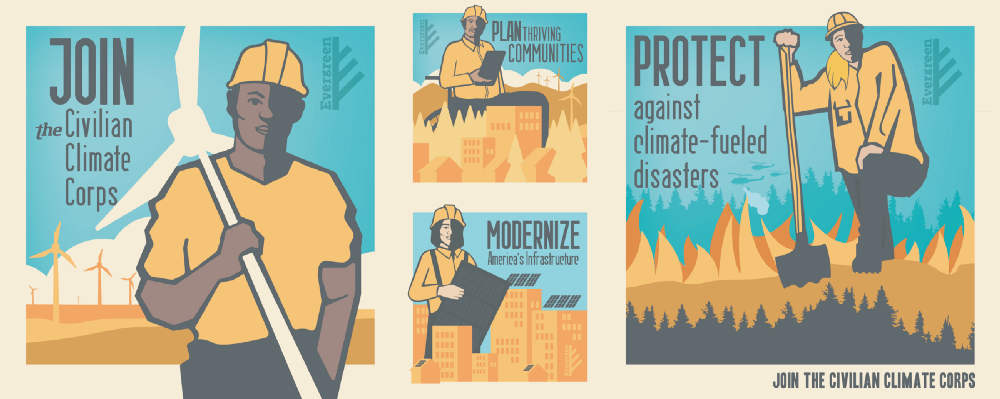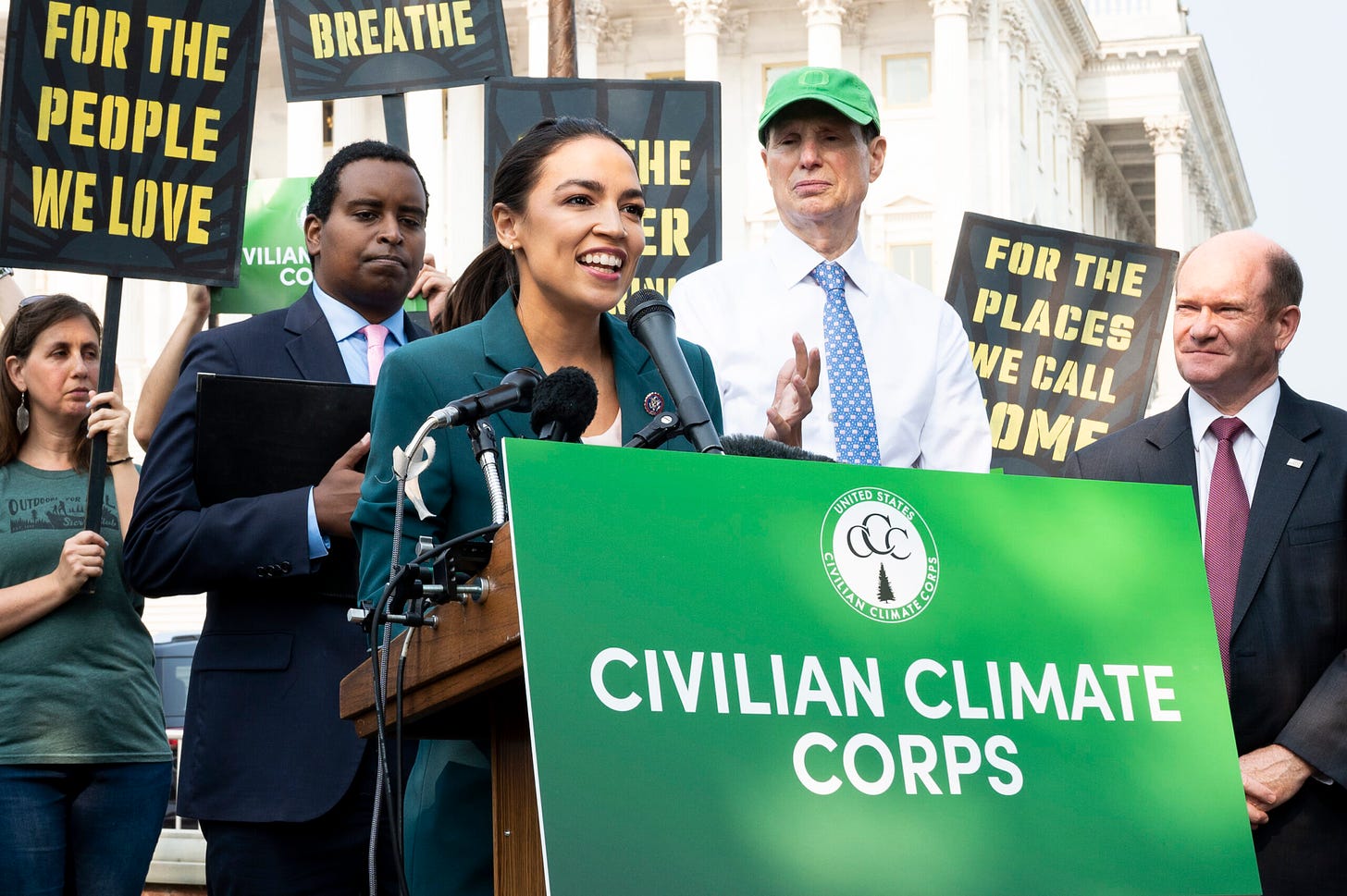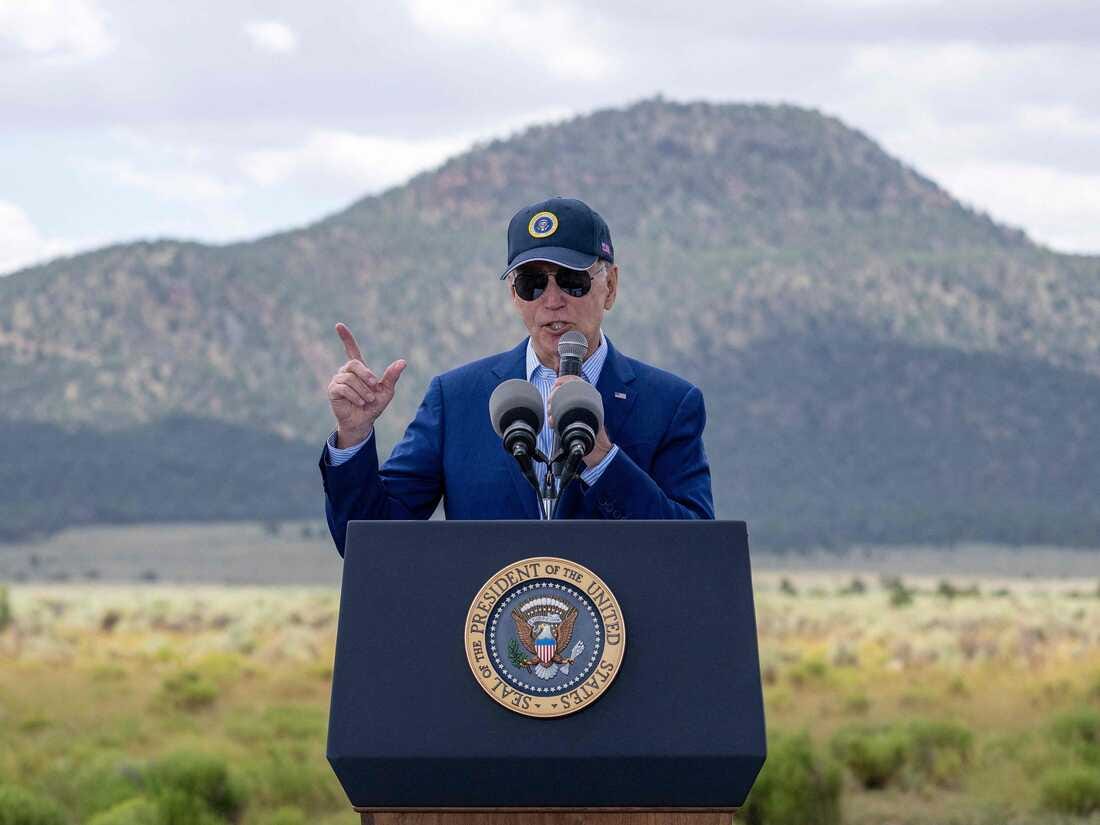Dive into Climate Drift: your guide to decoding climate solutions and recognizing your vital role in the path to net zero.
Haven't joined the movement? Subscribe now:
Hey there 👋
Skander here!
The software world took 40 years to hit 25M employees. Now, the climate sector has to rally 250M people in under a decade. This is a recruitment drive at a scale unseen so far. Or is it?
The US has tried to do something similar before with the Civilian Conservation Corps during the Great Depression - and it was successful, employing 3m people over the first 9 years of the program..
This week, Biden learned from history and launched the American Climate Corps. Let’s learn what the old CCC was and the new ACC aims to be.
Let’s dive in 🌊
The Origin: The Civilian Conservation Corps (CCC)
The Civilian Conservation Corps (CCC) was a U.S. government initiative from 1933-1942, targeting unemployed, unmarried men aged 18-25, later broadening to 17-28. A cornerstone of Roosevelt's New Deal, the CCC offered jobs in conservation and natural resource development on government-owned rural lands. Created during the Great Depression, the CCC aimed to provide jobs and financial relief to struggling families.
At its peak, 300,000 men enrolled. Over its 9 years of existence, 3 million young men participated, receiving shelter, clothing, food, and a monthly wage of $30 (with $25 sent home). Adjusted for inflation, that's roughly $678 today.
The CCC was the New Deal's star player, gaining massive public support. Beyond its immediate economic relief, the CCC also fostered a deeper connection between Americans and their natural landscapes, emphasizing the importance of conservation - if you hike in the US today you will still come across many CCC projects.
The CCC tackled a diverse range of projects, falling into nine key categories:
Structural Improvements: Including bridges, service buildings, and fire lookout towers.
Transportation: Development of truck trails, minor roads, footpaths, and airfields.
Erosion Control: Techniques such as check dams, terracing, and planting vegetation.
Flood Control: Encompassing irrigation, drainage, dam construction, and more.
Forestry: Tree planting, fire prevention and control, and pest management.
Recreation & Landscape: Crafting public campsites, picnic areas, and developing lakes and ponds.
Range Management: Creating stock driveways and managing predatory animals.
Wildlife Conservation: Stream improvements, fish stocking, and habitat creation.
Miscellaneous Tasks: Emergency responses, surveying, and mosquito control.
The CCC was a huge intergovernmental effort: Four departments collaboratively managed it. Labor (doing recruitment), War (camp operations), Agriculture, and Interior (organizing and project supervision).
In summary, the original CCC was a groundbreaking initiative. While some might see it as a strong application of socialism (a debate for another day), it undeniably lifted many from poverty, helped the US navigate the Great Depression more effectively, and mobilized masses to engage in environmental work.
Enter: A new CCC - the Civilian Climate Corps
Upon taking office, Biden marked climate change as one of his top 4 priorities, setting an ambitious target to cut U.S. greenhouse gas emissions by 50% of 2005 levels within the decade.
And the new Civilian Climate Corps was on the top of the agenda: Within his inaugural week, Biden expressed his intent through an executive order: He envisioned this corps as a means to empower a new wave of conservationists, focusing on resilience, extensive training, and job creation.
The idea of a Civilian Climate Corps (CCC) resonates across party lines and with a broader population. Recent polling from Data for Progress reveals that 77% of respondents endorse the CCC initiative. This includes a significant 65% of Republicans and an overwhelming 87% of Democrats.
Recent polling from the Yale Program on Climate Change Communication also found that 83 percent of Americans support reestablishing the New Deal-era Civilian Conservation Corps.
The 2022 Inflation Reduction Act earmarked a substantial $369 billion for climate-related incentives and expenditures - and originally planned $30 billion for "mobilizing the next generation of conservation and resilience workers" for the creation of the Civilian Climate Corps.
Unfortunately this did not happen - the program was dropped from the final version of the climate package during private negotiations.
Sen. Bernie Sanders proposed an amendment to reintroduce the Civilian Climate Corps to the package. However, Democrats uniformly resisted the amendment, emphasizing the need to maintain the bill's integrity. They also rejected all amendments put forth by Republicans.
The Civilian Climate Corps didn’t die however: in a grassroots push by organisations like the Sunrise Movement and through political force some money was found: The House passed a package allotting $31 million for it in summer of 2023, and the Senate proposed $20 million for related work through the National Park Service.
In the Inflation Reduction Act one can find $500 million for the Park Service and the Bureau of Land Management to pursue conservation and ecosystem restoration on public lands - which could also be used to build a new CCC and an additional $500 million is earmarked for the Park Service to hire new employees.
This of course falls short of the $30 billion originally planned.
So this leads us to this week: The announcement of the new CCC at the Climate Week in NY.
The new CCC - the American Climate Corps
Let’s take it directly from the announcement:
Today, through his Investing in America agenda, President Biden is delivering on that commitment by taking executive action to launch the American Climate Corps – a workforce training and service initiative that will ensure more young people have access to the skills-based training necessary for good-paying careers in the clean energy and climate resilience economy. The American Climate Corps will mobilize a new, diverse generation of more than 20,000 Americans – putting them to work conserving and restoring our lands and waters, bolstering community resilience, deploying clean energy, implementing energy efficient technologies, and advancing environmental justice, all while creating pathways to high-quality, good-paying clean energy and climate resilience jobs in the public and private sectors after they complete their paid training program.
So what is the plan?
Training & Opportunities: The Corps will train young Americans in clean energy, conservation, and climate resilience. They'll work on projects ranging from restoring coastal areas to deploying clean energy. All positions are paid and lead to quality job opportunities. No prior experience is needed for most roles.
Centralized Recruitment: The Federal government will soon unveil a recruitment site for the Corps, centralizing the application process. Key Federal departments will coordinate closely, with a memorandum to solidify their collaboration. AmeriCorps will also support through a dedicated hub.
Educational Awards: AmeriCorps is expanding access to Segal AmeriCorps Education Awards, which awarded $4B so far, for Climate Corps members. These awards help members fund further education or pay off student debts.
Simplified Civil Service Entry: A proposal from the Office of Personnel Management aims to make it easier for participants to transition into federal roles, especially those in national or tribal service programs.
How will it look like in reality?
For a tangible peek into what's to come, let's look at the freshly launched ForestCorp. A collaboration between AmeriCorps and the U.S. Forest Service, this $15 million initiative will train young individuals next year, ages 18-26, in wildfire prevention, reforestation, and more. Participants can expect compensation around $15 per hour, with perks covering lodging, transportation, attire, health benefits, and a living allowance. No prior qualifications are needed to dive in.
AmeriCorps, the federal agency for national service, isn't new to the climate battle. In 2022, they invested over $117 million into climate resilience and environmental conservation, marking a 20% leap from the year before. Last year alone, 14,500 AmeriCorps members contributed to environmental conservation—preserving vast land expanses, educating individuals on conservation, and rejuvenating waterways.
Some issues
Funding: The proposed budget for the Climate Corps is notably modest in comparison to historical benchmarks. For perspective, the original Civilian Conservation Corps received about $3 billion during its nine-year tenure, which equates to roughly $66 billion when adjusted for inflation. Given the pressing challenge of climate change, our present funding commitment seems less robust. Unlike the well-defined budget of its predecessor, the financing details for the new initiative remain unclear. Administration officials have yet to specify the program's exact funding or the sources of its allocation.
Lacking central organization: The original initiative was a monumental organizational endeavor, requiring seamless collaboration across various departments and agencies. It showcased a structured approach, wherein roles, responsibilities, and objectives were clearly delineated. In contrast, the structure for the current initiative seems ambiguous. There's a noticeable absence of a centralized framework guiding its operations, leaving many stakeholders in the dark about its direction and integration across departments.
From battling the dire straits of the Great Depression to now confronting the looming specter of climate change, both the CCC and the ACC reflect a commitment to harnessing the collective power of the American people in service of the greater good.
While the modern iteration faces its unique set of challenges—like funding ambiguities and the need for a more centralized command structure—the spirit remains the same: creating opportunities, fostering environmental stewardship, and leaving a mark on the nation's landscape and emissions.
I believe that for the corps to truly make a significant impact, there needs to be an overwhelming response from potential applicants. If the demand exceeds the current slots available, it could potentially drive the necessary funding and planning it deserves.
If you meet the criteria and think about joining up, I encourage you to register your interest here:
Skander
PS: Do you know someone who’d want to join or support the Climate Corps? Spread the word:











Really enjoyed this piece. Thanks for providing a bit more context.
I could see many countries replacing/expanding their mandatory military/civil service with climate service tracks.